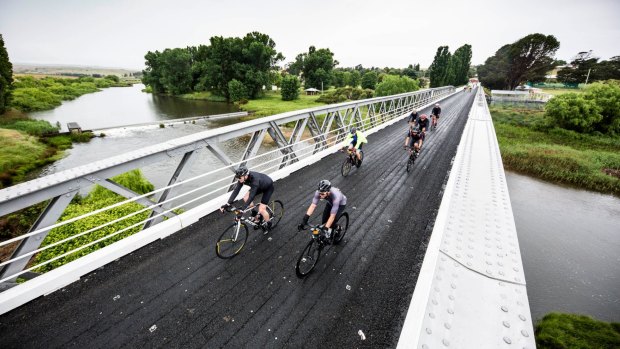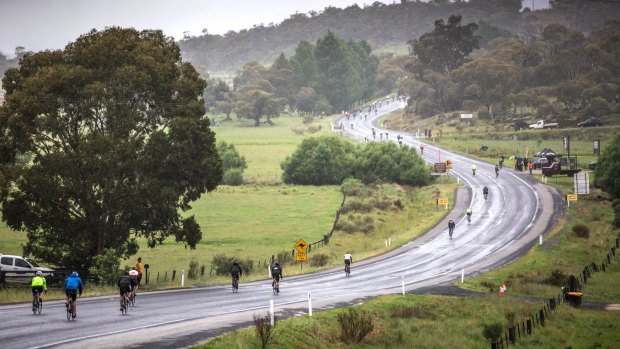This was published 5 years ago
L'Etape cycling route: A taste of the Tour de France in the Snowy Mountains
By Garry Maddox

Tour de France champion Chris Froome leads a group of riders in L'Etape Australia at Jindabyne.
For a cyclist, the company is impressive. Four-time Tour de France winner Chris Froome and Australian professional Amanda Spratt join more than 3000 riders for L'Etape, which simulates a stage of the Tour de France, in the Snowy Mountains last year.
Despite being out of season, Froome is an imposing presence on the road. Starting from the back of the pack, he effortlessly passes rider after rider on what amounts to a cheerful training ride for him. Still months away from the revelation that he had failed a drug test on his way to winning Spain's Vuelta earlier in the year, "Froomy" is a popular figure.
The British champion and Spratt are ambassadors for the event, which, like a Tour stage (or "etape"), features closed roads, support for riders and yellow, green and polka-dot jerseys for winners. But this is not just about cycling in the mountain air. The second L'Etape is a chance to get some insights into a professional team's approach to racing.

For most riders, L'Etape is more a cycling experience than a competition to be won. Credit: Beardy McBeard
The day before the event, Froome takes the stage in Jindabyne with cycling commentator Phil Liggett to talk about his career and why Team Sky has been so dominant in world cycling. He reveals that Sky has an advance team at grand tours who prepare hotel rooms for their riders – disinfecting their rooms, cleaning the doorknobs so they are free of germs, changing the shower heads so there is no risk of bacterial infection and swapping mattresses and pillows so they sleep in similar conditions every night.
If that seems like exceptional attention to detail, there is none of that intensity in the Snowy Mountains.
For most riders, L'Etape is more a cycling experience – a celebration of the sport – than a competition to be won. There were two events last year – a challenging race of 157 kilometres and a less strenuous ride of 126 kilometres. Both included a challenging climb up Col de Beloka. The start was at Crackenback, near the bottom of the Ski Tube, with commentator Matthew Keenan and Froome sending off waves of riders from 6.30am.

Riders battle wet conditions in 2017's event.Credit: Beardy McBeard
"You've got the serious riders at the front, who are there to win and push themselves very hard," race director Florent Malezieux says. "At the back, you have the guys who are there just to share a great moment on the road with friends."
The previous year, the first L'Etape in Australia is held in hot conditions. But the second instalment is so wet, with flooding at Rocky Plains and strong winds high in the mountains, that organisers have to cut the race short for the safety of riders. Both race and ride become 103 kilometres, finishing in Jindabyne instead of Perisher.
Even in sometimes soaking rain, it is a good-natured and colourful day in the saddle through striking alpine landscapes and small towns that are often decorated with cycling-themed artworks. A handful of riders dress for the weather with snorkels and goggles.
On the side of the road, locals hold encouraging signs, cheer and ring cowbells. One dresses as the red devil who supports the Tour every year. Another goes with a more Australian touch: cracking a stockwhip.
Away from the pacesetters up front, there is time to chat to other riders about where they have come from and other races they have done. And there are well-stocked food stations to grab a bite or a drink – and stretch – before setting off again.
The steepness of Beloka shows why L'Etape is a few steps up from the likes of the annual Gong ride from Sydney to Wollongong. At 1119 metres almost 90 kilometres into the race, it averages a testing 9.9 per cent over 3.5 kilometres after starting with a brutal 13.2 per cent pinch.
According to Malezieux, the Australian event is one of 15 L'Etapes around the world. By its second year, it had already become the biggest outside the original in France, which takes place during the Tour with 15,000 amateur riders.
It is a welcome addition to the annual calendar of endurance races that includes Fitz's Challenge (across Canberra's Brindabella Ranges), the Bowral Classic (in the NSW Southern Highlands) and Three Peaks (in Victoria's High Country).
Even Froome has noticed that Australia's cycling culture has grown stronger since Cadel Evans' historic Tour win in 2011. "You only have to look at the sides of the road in the Tour Down Under in Adelaide and how many people are really into the sport and actually ride bikes themselves," he says. "Those are the kind of people who are coming along to events like L'Etape."
After feedback from riders last year, the organisers have changed the routes this year – starting and finishing the event in Jindabyne. That means the race will be longer at 170 kilometres. It will head to Rocky Plains and Berridale, with King of the Mountain sections at Beloka and Col de Kosciuszko (1725 metres, 23.5 kilometres at 4.4 per cent). There will be 3000 metres of vertical climbing and a long descent to the finish, supported by four food and two energy zones.
The organisers describe the route as being as tough as a mountainous stage of the Tour.
"It's a very good course," Malezieux says. "You have the reward of the long descent – 21 kilometres – back from Perisher to Jindabyne before a barbecue in the village."
The ride will be 108 kilometres – following the same route as the race but returning to Jindabyne after Beloka. It has 1600 metres of vertical climbing, with two food and one energy zones.
Just don't expect to see Froome this year. Spratt will be joined by another Australian professional, 2016 Paris-Roubaix winner Mathew Hayman, as ambassadors for the third L'Etape.
TRIP NOTES
MORE
traveller.com.au/snowy-mountains
DRIVE
By road, the NSW Snowy Mountains can be reached in five hours from Sydney, six and a half hours from Melbourne, two hours from Canberra and 45 minutes from Cooma. Regional Express flies to Snowy Mountains Airport at Cooma.
RIDE
L'Etape Australia is on December 1 this year. Registrations are at letapeaustralia.com
STAY
Lake Crackenback Resort and Spa (1650 Alpine Way, Crackenback) has modern lake and mountain-view apartments with one to three bedrooms in a resort setting. It features restaurants – the stylish Cuisine features a signature Aylesbury duck breast and the more casual Alpine Larder does woodfired pizzas, burgers and grills – a spa and such activities as Segway and mountain bike tours, river-sledding, fly fishing tours and guided walks. See lakecrackenback.com.au Around the Snowy Mountains, there is also a range of accommodation at Berridale, Charlotte Pass, Cooma, Dalgety, Jindabyne, Perisher and Thredbo.
EAT
The Snowy Mountains has become a popular "foodie" area in recent years. In Jindabyne, Birchwood Cafe (3/3 Gippsland Street) serves healthy and tasty breakfasts and lunches and good coffee. Just outside the town of Jindabyne, Wildbrumby Schnapps Distillery (corner of Alpine Way and Wollondibby Road) has a relaxed cafe in a garden setting that serves European-style meals such as German smoked sausages, schnitzels and Austrian beef goulash alongside its own schnapps and gin.
Garry Maddox travelled to the Snowy Mountains courtesy of Destination NSW.
Sign up for the Traveller Deals newsletter
Get exclusive travel deals delivered straight to your inbox. Sign up now.